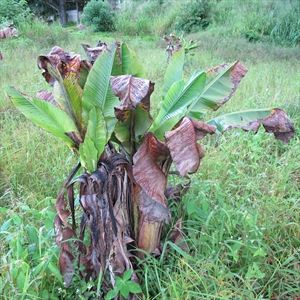Banana aphid
Pacific Pests, Pathogens, Weeds & Pesticides - Online edition
Pacific Pests, Pathogens, Weeds & Pesticides
Banana aphid (103)
Pentalonia nigronerversa
It has been reported in Australia, Cook Islands, French Polynesia, Fiji (where it was first described), Guam, Marshall Islands, Niue, Northern Mariana Islands, Papua New Guinea, Samoa, Solomon Islands, Tokelau, Tonga, Vanuatu, and Wallis and Futuna.
Banana, other Musa spp., and relatives - Heliconia, Strelitzia and Ravenala; other hosts are Canna and Zingiber species (gingers), and members of the Araceae, including taro and Xanthosoma.
Pentalonia aphids (Photo 1) damage plants in three ways: (i) they take nutrients and water from the plants by feeding on their sap, (ii) by producing honeydew that attracts dark fungi called sooty moulds, and (iii) by spreading viruses. Insects that spread viruses are called virus 'vectors'. In this case, Pentalonia is the vector of Banana bunchy top virus.
Male aphids of this species are unknown, so reproduction occurs without fertilisation - known as 'parthenogenesis'. Eggs are also unknown; instead, females give birth to living young - known as 'viviparity'. Two to four young are born each day. The nymphs go through four moults. When adult they are up to 1.5 mm long, shiny red-brown or almost black, usually wingless (Photo 1). Winged adults appear after 7-10 generations. The wings have characteristic dark veins. Aphids are not strong flyers, but travel long distances on light winds. They are most abundant in the wet season.
Young aphids - the nymphs - are more efficient at spreading the virus, but it is more likely that winged adults start new infections. Pentalonia has long mouthparts called stylets that pierce plants to suck sap from the phloem - the tubes that take nutrients from the leaves to the roots. Aphids pick up the virus after feeding on infected bananas for about 18 hours, and keep it for the rest of their lives (15-20 days).
Sometimes, large colonies of Pentalonia kill banana suckers, but this is rare. Large colonies may sometimes mark fruits, but this too is unusual. Sooty mould fungi grow on aphid honeydew, but damage to plants is uncommon, although there are reports of moulds at the base of leaves causing rots.
Major damage is caused by spread of Banana bunchy top virus (BBTV) (Photos 2-4). In parts of Samoa and Tonga, the disease caused by this virus has stopped commercial banana production.
Look for colonies near the midrib on the underside of the leaf, under the sheath that wraps around the stem, or on the fruit. Look for brown-black aphids with prominent black wing veins. Look for ants that are attracted to the aphids' honeydew. Colonies may occur below the soil.
NATURAL ENEMIES
In Samoa, two predacious ladybird beetles were imported, and in Tonga two braconid wasp parasites, Lysiphlebus spp. None of these introductions reduced BBTV to acceptable levels. Indigenous lacewings and syrphid fly larvae (the adults are hoverflies)also attack aphid colonies.
CULTURAL CONTROL
Cultural practices are important in preventing outbreaks of this disease. Do the following:
-
Maintain good weed control around the banana patch; some weeds may host Pentalonia.
-
Check alternative hosts for aphid populations, and eliminate as necessary (see below).
-
Keep banana mats pruned of unwanted suckers. Aphids prefer to feed on young suckers.
RESISTANT VARIETIES
Pentalonia is not normally found on plantains. However, all Musa species and varieties are susceptible to BBTV. In Australia, variety Gros Michel is more resistant to BBTV than Dwarf Cavendish. In Fiji, variety Veimama shows resistance; it may be infected by a mild strain of BBTV.
CHEMICAL CONTROL
Kill the aphids on bananas as soon as symptoms are seen; this is important. Do the following:
-
Strip away old leaf sheaths from around the base of the plants, and kill the aphids on the plants by one of the following methods, spraying the stem thoroughly with insecticide, paying special attention to the 'throat' and funnel leaves. Spray each of the suckers as follows.
-
Use derris or pyrethrum. (Note, many of the chemicals recommended previously in Pacific island countries have been banned or restricted in their use.)
-
Use soap or oils (white or horticultural) (see Fact Sheet no. 56).
-
Use a synthetic pyrethroid.
-
Use kerosene, or a mixture of diesel and mineral oil.
-
-
After 1 week, spray the infected plants with herbicide (glyphosate).
-
Remove the dead plants and burn them.
--------------------
Note, derris (Derris species) contains rotenone, an insecticide, often used as a fish poison; it should be used with caution. The commercial derris insecticide is made from Derris elliptica.
____________________
When using a pesticide, always wear protective clothing and follow the instructions on the product label, such as dosage, timing of application, and pre-harvest interval. Recommendations will vary with the crop and system of cultivation. Expert advice on the most appropriate pesticides to use should always be sought from local agricultural authorities.
AUTHOR Grahame Jackson
Information from Waterhouse DF, Norris KR (1987) Pentalonia nigronervosa Coquerel. Biological Control Pacific Prospects. Inkata Press; and DAF (2017) Banana aphid. Queensland Government. (https://www.daf.qld.gov.au/business-priorities/agriculture/plants/fruit-vegetable/insect-pests/banana-aphid); and from CABI (2019) Pentalonia nigronervosa (banana aphid). Crop Protection Compendium. (https://www.cabi.org/cpc/datasheet/39598). Photo 2 Richard Markham, ACIAR, Canberra.
Produced with support from the Australian Centre for International Agricultural Research under project PC/2010/090: Strengthening integrated crop management research in the Pacific Islands in support of sustainable intensification of high-value crop production , implemented by the University of Queensland and the Secretariat of the Pacific Community







